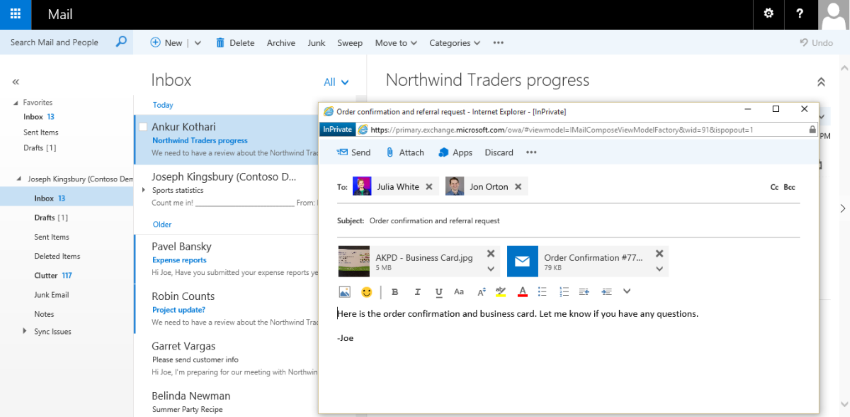Microsoft has announced the public release of Exchange Server 2016 Preview, available for download now.
This version of Exchange is special because it was born in the cloud. From the depths of the mailbox store to the most visible parts of the Outlook web UI, the bits that make up Exchange 2016 are already in use across millions of mailboxes in Office 365. For the past several months we’ve been working to package up these capabilities and deliver them on-premises. This preview milestone is an important step in that process, and we’re excited to include the worldwide Exchange community in the journey.
For Exchange admins a new release like this can be an exciting time. Looking at the information in Microsoft’s announcement and the documentation already available on TechNet (which is incomplete of course, but we can expect it to fill up rapidly in the coming months) there is certainly plenty to get excited about.
For Exchange Server 2013 customers there are no unpleasant surprises and we can mostly enjoy the improvements in performance, manageability, and user experience.
For Exchange Server 2010 customers there are more obvious changes, mostly in areas that Exchange 2013 customers are already used to such as the changes in management tools and the server roles architecture.
Architectural Changes in Exchange Server 2016
The big change in the server roles architecture is the further consolidation of server roles into just two:
- Mailbox server role
- Edge Transport server role
The Mailbox server role consolidates both of the required Exchange Server 2013 roles (Mailbox and Client Access), and all of the required Exchange Server 2010 roles (Mailbox, Client Access, Hub Transport, and Unified Messaging) into a single server role.
Within that single server role there still exists the concept of “Mailbox services” and “Client Access services”, but the immediate benefit is no more confusion over whether to deploy separate roles or multi-role servers.
This purpose of the Edge Transport role remains unchanged, designed to sit in perimeter networks and provide secure inbound and outbound mail flow. As with previous versions of Exchange this is an optional server role.
Co-Existence Improvements in Exchange Server 2016
Welcome news for Exchange Server 2013 customers is the capability for Exchange Server 2013 and 2016 to proxy client traffic to each other, instead of having to cut over all client access namespaces to the higher version during a co-existence period. This will ease the migration path for many customers, and no doubt makes the transition within Office 365 easier for Microsoft to manage as well.
Outlook on the Web (formerly Outlook Web App)
Outlook’s web-based experience is going through yet another name change, now generally referred to as “Outlook on the web” to align with the unification of the Outlook brand across all platforms.

I use Outlook Web App daily and the richness of the experience means I don’t miss the full Outlook application at all when it is not available to me. More improvements in Outlook for the web are always welcome by me, and I’m particularly interested in the new “Pins and Flags” features, as I like to “pin” items to the top of my mailbox as a sort of “to do” list (Outlook.com already behaves this way when you flag an item).
Faster Search Performance
As mailboxes get bigger and more mail items are kept for longer periods of time search becomes more and more important for end users. For years now I’ve personally used a “just file it into one folder and use search to find it later” approach to keeping my Inbox from accumulating too many items, and I meet more people taking this approach as time goes on.
Microsoft says:
By studying real-world data about how people search and analyzing the speed at which results are returned, we’ve implemented changes to the search architecture and user interface of Office 365, which are now coming on-premises.
The overall speed of server side search is significantly improved in Exchange 2016. But more importantly, the Outlook client now fully benefits from the power of server-side search. When a cached mode Outlook 2016 client is connected to Exchange, it performs search queries using the speed and robust index of the server, delivering faster and more complete results than desktop search.
Some insight into this research was shared by Karim Batthish during the “Meet Exchange Server 2016” session at Ignite 2015, and I highly recommend watching it as it was very interesting to see how Microsoft approached this challenge.
Modern Authentication for Outlook
Exchange Server 2016 supports modern authentication, which has been discussed for Office 2013 and Office 365 scenarios in this blog post by Microsoft.
One of the scenarios this opens up is the use of multi-factor authentication for Outlook clients connecting to on-premises Exchange Server 2016. Having worked with many customers who block Outlook Anywhere for the lack of MFA support this is a welcome addition.
New Hybrid Configuration Wizard
The Hybrid Configuration Wizard for configuring a Hybrid Exchange and Office 365 deployment has been removed from Exchange Server 2016 and is now a standalone tool.
In the past there has been times when changes in the cloud broke the HCW for Exchange Server 2013, which then couldn’t be fixed until the next cumulative update was released. Now as a separate tool Microsoft can maintain the HCW with any changes or fixes required to continue working with Office 365.
Other Changes
The list of significant changes is much longer than just those items above, and you can expect that I and others in the Exchange community will be sharing a lot of information over the coming months as we get closer to Exchange Server 2016 RTM.
Other changes of interest include:
- MAPI over HTTP is being prioritized as the Outlook connectivity protocol, with RPC over HTTP de-emphasised and likely to be phased out in future versions of Exchange.
- Exchange Server 2016 database availability groups will be created without an IP address (administrative access point) by default, but can be created with an IP if necessary. Backup software vendors need to get on board with this change if they have not already.
- Auto-expanding archive mailboxes, recently enabled in Office 365, will be available in Exchange Server 2016 (but only accessible past the initial 100Gb limit by Outlook 2016 and Outlook on the web).
- Many improvements and updates to compliance features like DLP, transport rules, in-place hold, and eDiscovery.



Why is there so much chatter about ADAL and modern authentication with Exchange Server 2016 but absolutely no documentation? How does one get this enabled for on prem?
Thanks
Still no documentation about on-premise ADAL configuration. Anyone successfully implemented?
Morning Paul, I have a slight issue with one of our Exchange servers. We have 3 Exchange servers I’m able to connect the EMS on two servers. However I’m unable to connect to one of the servers. I receive the following error message If I use the management tools GUI i get an error message saying:”Connecting to remote server failed with the following error message: The WinRM client received an HTTP server error status (500), but the remove service did not include any other information about the cause of the failure. All the servers are figured the same way. I log on from another machine received the same error message, deleted my AD profile received the same error. I’m lost need help…
Thanks Paul!
One omission seems to be that 2016 now does Content Indexing off the passive copy, thereby reducing DAG replication by over 50%. I thought that was the other big architectural change that was mentioned at Ignite?
Cheers
Twan
can you tell us why microsft Exchange team do not support windows mode core ?
as EMC does not exist anymore in ex2013 and 2016. the only thing needeed is http EAC…available by dns resolution everywhere (internally) in your organisation.
DL in progresss gonna try this on a brand new lab !!! im so excited to figure out coex with ex2013 (proxy 2013——2016)